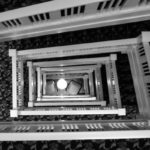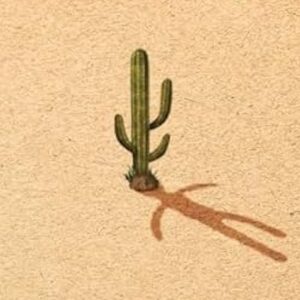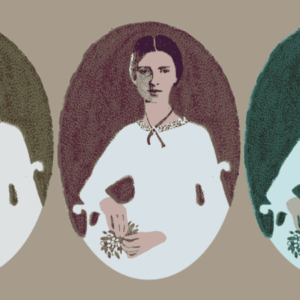
The Life and Death of the Library of Alexandria
One of the Great Centers of Human Knowledge, Ever
In 1960, four novels by the well-known English writer Lawrence Durrell were brought together in one volume and published as The Alexandria Quartet. Described by its author as “an investigation of modern love,” it was set in the Egyptian city of Alexandria before and during the Second World War, and was largely based on Durrell’s own experiences during his time there as a press attaché. The Quartet traced the personal lives of a number of key characters—seemingly based on real individuals, including Durrell’s second wife—from different, competing perspectives. He later claimed, however, that, out of all of the people portrayed and incidents featured, “only the city is real.”
Alexandria was the true hero of the book: an exotic, darkly seductive and sensuous city, fragrant of “offal and drying mud, of carnations and jasmine, of animal sweat and clover.” Durrell painted a picture of a cosmopolitan, Greco-Arab outpost, where East met West in a delicious collision of hotels, hashish cafés, colonial villas and squalid slums, all set between the blankness of the desert and the blue of the Mediterranean. Yet Durrell’s Alexandria was far from a product of the 20th century alone. Instead he called it a “capital of memory,” a place that still held on to the “echoes of an extraordinary history.” It was a remnant and a shadow of a much greater city, one born out of a dream two-and-a-half thousand years old.
In 331 BC, according to the Greek historian Plutarch, after successfully conquering Egypt, Alexander the Great received a vision in his sleep. A “grey-haired man of venerable appearance,” told him of “an island in the much-dashing sea in front of Egypt: Pharos is what men call it.” Alexander believed that this visitation was the Greek poet Homer, communicating from beyond the grave. When he travelled to view Pharos, he declared it to be the perfect spot for a city: a city that would bear his name, and that would become a new capital of the ancient world.
With his architect Dinocrates, the young emperor paced out the plan of “Alexandria,” scattering barley meal in the sand to mark the locations of palaces, streets and buildings. The city was rectangular in shape and ordered in a grid system, with its length exactly double its width—a design said to be modeled on the chlamys, the woollen military cloak worn by Macedonian warriors. A causeway was built between the mainland and the island of Pharos, spanning the sea from the vast royal palace complex that had emerged along the shoreline to create two huge, man-made harbors.
Fresh water was diverted from the mouth of the Nile, running along a twenty-mile-channel into a series of tunnels and great, vaulted cisterns carved out of the rock beneath the city. At the tip of the island, marking the entrance to the port, was a colossal white marble tower: the Pharos—or lighthouse—of Alexandria. At its top, 100 metres above the city, fires were lit and directed with mirrors of polished metal, creating a beacon visible, some said, over 300 miles out to sea.
Little of this Alexandria remained in the city that so captivated Durrell. Certainly, little that could be seen and touched. Over the course of a thousand years, between around 300 and 1300 AD, a series of massive earthquakes, originating in a fault-line that ran from Sicily to Cairo, struck the Egyptian coast. The harbor front dropped slowly closer and closer to the sea, before its great cluster of grand, ornate buildings started to topple into the water, eventually sinking beneath the waves.
In the mid-1990s, marine archaeologists rediscovered this ancient city in fragments lying scattered across the seabed of the modern port. They found hundreds of fallen columns and capitals, sphinxes sunk into the silt of the harbor floor alongside broken obelisks, and huge stone blocks covered in hieroglyphs and Greek inscriptions. The ruin of the great lighthouse was there too, still lying where it had crashed down into the water after an earthquake in the early fourteenth century. Durrell had described it in the Alexandria Quartet, writing of the “Ancient Pharos, whose shattered fragments still choke the shallows”; and one of his characters “had once wanted to start a curio trade by selling fragments of the Pharos as paperweights.” The plan was to smash off the pieces with a hammer “to deliver them to retailers all over the world.” This was no idle whimsy. Nearly three decades after Durrell wrote his novel, people were doing just that with graffiti-dyed chunks of the Berlin Wall.
Although it was built on Egyptian soil, Alexandria was at first a determinedly Greek city, established as the main trading hub of an Empire stretching from the Mediterranean to eastern India. Over time, however, its atmosphere and its architecture became a blend of classical and oriental influences, a mishmash of styles reflecting both its diverse population and the individual tastes of a succession of increasingly self-indulgent—and corpulent—kings. Yet what made the city truly unique was its role as a center for learning and scholarship. Alexandria was built around a simple yet staggeringly ambitious idea: that of holding in one place all of the knowledge ever accumulated by man. A Great Library was established there to become the memory bank of the ancient world, filled with papyrus and parchment scrolls containing everything from poetry, drama and literature, to advanced treatises on mathematics, anatomy, geography, physics and astronomy.
The library became one of the original and most spectacular hostages to fortune in all of world history. The tenet “knowledge is power” was its founding creed; yet if knowledge is power, it can also be threat, temptation, corruption and heresy. It was a sequence of natural disasters that saw the original city swallowed by the sea, but Alexandria’s library had vanished long before. It was claimed neither by cataclysm nor by catastrophe, but by man.
The classical Greek playwrights had invented the concept of “hubris,” the fall that comes after overweening pride and ambition. Looking back across the millennia, there seems a terrible inevitability about the fate of the library at Alexandria. What other destiny could have awaited this first, universal archive—the store of all human intellectual achievement—than total destruction?
In 1996, as construction workers cleared a site in downtown Athens for the foundations of a new Museum of Modern Art, they found traces of a large structure sitting on the bedrock. A building had occupied this same spot some two-and-a-half thousand years earlier, when it was part of a wooded sanctuary outside the original city walls, on the banks of the River Ilissos. The excavation uncovered the remains of a gymnasium, a wrestling arena, changing rooms and baths. This had been a place for athletics and exercise, where the young men of Athens had trained to become soldiers and citizens. But it was more than just a center for physical improvement. The archaeologists soon realized that they had found one of the most significant sites in all of western European intellectual culture, a site referred to continually by history’s greatest philosophers: the Lyceum of Aristotle. The world’s first university.
As the dig continued, they uncovered the very chamber where Aristotle had lectured his students on logic, ethics, politics, economics, literature and science. It was only large enough to fit around ten people, but then Aristotle had never confined his teaching to the classroom. According to contemporary accounts, he ranged all over the grounds of the Lyceum, walking as he taught. His followers called his school the “Peripatos,” from the Greek meaning “walkway,” and they in turn became known as the “Peripatetics.” His lecture notes were written down and incorporated into a small, private library, taking their place alongside a selection of prized scholarly books collected from his travels across the ancient world.
Aristotle had established his school at the gymnasium around 335 BC. For the previous eight years he had worked as personal physician and tutor to the son of Philip II of Macedon: young Prince Alexander, before he became “Great.” This was Aristotle’s most famous pupil, although he also worked with two of Alexander’s well-known friends—Ptolemy and Cassander. Eventually relations between the teacher and his protégé broke down irrevocably. Alexander matured to manhood and came to the throne of Macedonia. As his power grew, and more and more territories fell to his army, he began to assume the role not just of a great leader—perhaps the greatest history had ever known—but also of a god. Aristotle viewed this irrationality with a mixture of amusement and contempt.
Nevertheless, Aristotle had instilled in Alexander an enduring respect for education and scholarship. It was the philosopher’s teachings that inspired his student to envision Alexandria as the high watermark of Greek culture: a custom-built metropolis, designed according to purist principles. But Alexander died before he could begin work on his great project. In 323 BC, as he rested in his royal palace in Babylon, he succumbed either to malaria or poisoning. Some rather far-fetched, ancient gossip even linked Aristotle to an assassination plot. In the end it was Ptolemy, Alexander’s childhood accomplice, trusted general, and one-time fellow Aristotelian classmate, who would establish Alexandria as a world center for the Greek arts.
At the heart of the city’s palace complex, which stretched along the harbor front opposite the island of Pharos, Ptolemy founded two great institutions: a “Shrine to the Muses”—a building known more commonly today as a museum—and a huge library. To run the library, Ptolemy turned to a fellow disciple of Aristotle—Theophrastus, the new head of the Athenian Lyceum. Theophrastus declined the offer, but recommended instead one of his best students, Demetrius of Phalerum. For Demetrius, the timing could not have been better. In 317 BC, Cassander, the third of the young Macedonian pupils of Aristotle, had appointed Demetrius as ruler of Athens. For a decade Demetrius had tried to organize the city according to the high-minded political and philosophical ideas of his great teachers. The attempt was something of a disaster. By the end of his reign, the Athenians regarded him as little more than a tyrant whose lecture-hall theories were utterly ill-equipped to deal with governance in the real world. Overthrown and exiled from the city—on pain of death if he ever returned—Demetrius had been languishing back under the cloak of Cassander at his court in the Greek city of Thebes. The opportunity of royal patronage to embark on another great intellectual endeavor—a safe distance from Athens—was too good to pass up.
One of the earliest surviving accounts to make specific mention of Alexandria’s library comes in the middle of the second or third century BC (the actual dating is a matter of much debate), written by Aristeas, a Jewish scholar who had come to live and work in the city. In a letter to his brother Philocrates, he appears to detail both the extraordinary progress made by Demetrius after being put in charge of the institution, and the vast scope of the task set by Ptolemy:
[Demetrius] was assigned large sums of money with a view to collecting, if possible, all the books in the world; and by arranging purchases and transcriptions he carried the king’s design to completion as far as he was able. When he was asked, in my presence, about how many thousands of books were already collected, he replied: “above two hundred thousand my king; and in a short while I shall exert every effort for the remainder, to round out the number of half a million.”
Aristeas also recounts his own involvement at the library, along with 71 other Jewish scholars, in one of the most significant projects of ancient history: translating into Greek the writings that would later form the Christian Old Testament.
Alexandria’s library was not the first the world had ever known. Attempts had been made to collect and preserve writing almost from the moment that it had been invented. The Mesopotamians, for instance, had established a number of royal libraries; Egyptian priests had managed great archives of diplomatic correspondence written on scrolls or tablets; and the Assyrian King Ashurbanipal had kept a huge collection of works inscribed in baked clay, which included the Epic of Gilgamesh, the world’s earliest known work of literature. Yet nothing had come close to the ambition of Alexandria. Conceived by the students of Aristotle, now among the most influential figures in the western world, it combined philosophical and intellectual purity with swaggering imperial might. The modest model of the Athenian Lyceum and its private library was re-imagined on a gargantuan scale: as if the voracious quest for “more worlds” in Alexander’s reign had been replaced by an equally urgent search for knowledge. In both cases, however, the objectives were clear: prestige and power. As humanity’s intellectual capital, Alexandria could stand proud above every other city on earth.
Like today, most libraries in the ancient world grew through acquisitions, gifts, bequests and loans—as well as, of course, from the writing and depositing of entirely new texts. In Alexandria, however, where the goal was to gather and catalogue every book ever written, the collections strategy was more extreme. The Ptolemy dynasty instituted a law that any book brought into the city had to be passed immediately to the library’s scribes for copying. More often than not, the original was kept and the copy returned to its owner. The thousands of ships docking in the city’s three inter-connected deep-water harbors were searched routinely, and any texts not already declared and unloaded onto the quay-sides were seized and confiscated.
So many books were added to the library through this method, that they received their own categorization: a label attached to each parchment that read “from the ships.” Agents were employed to travel to book markets across the Mediterranean in search of rare and original works. In the third century BC, Ptolemy III sent emissaries to all the kings and leaders in the known world, asking to borrow their books for copying. When the Athenians lent him the master copies of the works of the great Greek tragedians Aeschylus, Euripides and Sophocles, the king kept the originals and sent the fresh copies back across the sea, regarding his forfeited deposit of 15 talents as a small price to pay for so precious a set of first editions.
The shelves—or theke—of the library filled up at an incredible rate. At the same time, the Ptolemies worked jealously to establish a monopoly on the practice of collecting and curating information. When a rival library was established at Pergamum in present-day Turkey, they banned the export of Egyptian papyrus, an attempt to cut off at source the “oxygen” for the creation and copying of books. The Pergamum library struggled on, with their scribes forced to work on parchments made from animal skins. As the reputation of Alexandria grew, its combination of reference works, scholarship and research began to reach critical mass. Academics flocked to the city on the promise of free board and lodging in the opulent royal quarter, as well as exemption from taxes, funding for study, and of course access to the library. It became an irresistible magnet for the great minds of the ancient world. They could flourish under the patronage of their Greek kings, and devote their lives to nothing but the pursuit of knowledge. The dream of the Ptolemaic rulers was crystallizing into an ever more potent reality: as the intelligentsia flooded the city, the kings came to hold dominion over the Empire of the Mind.
Towards the end of the second century BC, the scholar Athenaeus described the fame the library had achieved in the ancient world. “What reason is there for me even to speak of the number of books, the establishment of libraries, and the collection in the Museum,” he wrote, “considering how they are all the memories of everyone?” Yet in his account Athenaeus also appeared to hint at the drawbacks of accumulating such a vast repository of data: too much raw, unprocessed knowledge can be little different to no knowledge at all.
The Roman architect and engineer Vitruvius’s description of the life of Aristophanes of Byzantium, who was Alexandria’s head librarian at the start of the second century BC, stood as a similar warning of the dangers of bibliomania: “Every day he did nothing other than read and reread all the books of the Library, for the whole day, examining and reading through the order in which they were shelved.” If he was not careful, the librarian could be swallowed up by his own library.
It became clear that the scale of the Alexandrian enterprise presented a new and unique challenge. Once you had brought all of the works of man under one roof, how could you then go about finding information on just one specific topic? The answer was to invent an entirely new system for identifying, registering and locating texts. This monumental task fell to the critic, poet and scholar Callimachus of Cyrene, who devised a system called the Pinakes—literally, the “Tables”—which compressed and categorized any given book into an abbreviated shorthand.
The Pinakes divided texts by genre and subsection, ordered authors alphabetically, offered potted biographies and lists of their other works, included titles and opening words, and provided estimates of the extent of each individual work by number of lines. It was the creation of an archive within an archive, the key that unlocked the library’s vast data bank. Callimachus changed forever how we engage with writing. Massive works were reduced to basic ciphers, signposts inviting a scholar to read on, or move on. All of a sudden, books were defined by their catalogue entries, translated into a new grammar of genres, titles and line-counts—the universal language of the index.
If some were dismayed by the implications—in particular by the subjectivity inherent in the summarizing process—without the Pinakes, the library would have been unusable. Callimachus’s innovation transformed Alexandria, and remains the basis for the cataloguing and bibliographic system we use today. For the first time, scholars could access information on a huge range of diverse subjects, and consult, process and synthesize data all at once. The results were sensational.
As early as 235 BC, the geographer and mathematician, Eratosthenes of Cyrene was proposing not only that the earth was round—in an age when almost all believed it was flat, with an edge off which the unwary could drop—but had also calculated its circumference and diameter (the former to within 200 miles of its actual size, the latter to within 50 miles). He was also able to conclude that all the oceans were connected, and was the first man in history to suggest the possibility of circumnavigating the globe. But scholarship at Alexandria was not confined to exploring the extent and properties of our own world. Men like Timocharis, Hipparchus, Aristyllus and Claudius Ptolemaeus created maps of constellations and catalogued thousands of stars. Nearly two millennia before Copernicus, Aristarchus of Samos put forward the theory that the sun was the center of the universe, and that the earth and all the other planets in the solar system revolved around it in a circle.
In the dissection rooms of the Museum, huge advances were made in medical science, aided by the Ptolemies’ willingness to offer up dead bodies for study. Chillingly, it was also rumored that condemned criminals were supplied “out of prison by the Kings,” to be subjected to the horrors of vivisection. Herophlius’s study of the brain at Alexandria led to the discovery of the central nervous system and the role of the veins in blood circulation, proposing, for the first time, that the brain, and not the heart, housed the human mind. His younger colleague Erasistratus, with whom Herophilos founded a school of anatomy, carried on this groundbreaking work, mapping all of the body’s arteries, identifying the respiratory function of the lungs, and exploring the digestive system to conclude, among other things, that the feeling of hunger stemmed from an empty stomach.
In the early third century BC, the mathematical genius Euclid wrote the Elements at Alexandria, a series of proofs and axioms drawn together in a single, logical treatise. It was the founding work of mathematics and geometry, the definitive reference book enabling every future scholar to apply universal theories to myriad practical applications. As a result, engineering and physics flourished in the city. It was here, for instance, that Archimedes invented his enduring “screw” water-pump, and experienced his famous “Eureka!” moment to create calculus, his methodology for working out areas and volumes. But the many great advances were not confined to endless rolls of parchment and lines of shelving. Over time, this feverish spirit of discovery and invention spilled out of the halls of learning to transform the city itself.
Alexandria became the setting for awe-inspiring wonders. Operated by running water, mechanical birds sang and whistled from the tops of trees and fountains. Using compressed air, statues would blow trumpets, raise wineskins to their lips, or shoot arrows. Temple doors would open and close automatically, controlled by the lighting and extinguishing of fires. The city’s wide, central avenue was lit at night by automatic, air-powered street-lamps burning olive oil. These devices came from the mind of Hero, a native of Alexandria in the first century AD, and one of the most prolific innovators of the ancient world. The founding father of hydraulics, he explored in his master-work Pneumatica how “by the union of air, earth, fire and water, and the concurrence of three or four elementary principles, various combinations are effected, some of which supply the most pressing wants of human life, others produce amazement and alarm.”
Hero’s box of tricks also included the coin-operated drink-dispenser—“a sacrificial vessel which flows only when money is introduced”—and the syringe. In his construction of a short play performed by automata, controlled by weights winding ropes and strings back and forth around an axle, he is credited with building the very first programmable robot. Most remarkable of all, however, was what he named the “Aeolipile,” after Aeolus, the Greek God of the air and winds. A sphere held above a heated, water-filled cauldron was made to revolve perpetually under the power of pressurized steam. Hero intended this as a simple amusement, an intriguing toy that proved a theory. What he had in fact created was the world’s first steam engine and turbine, the same “motor” for the Industrial Revolution, 16 centuries later.
Looking back now, the imagination is sent reeling by the possibilities. Imagination, of course, is almost all that we have left. At some point in ancient history, we know that the library and its priceless contents were destroyed, most likely burned to ashes. A vast tract of the collective memory and accomplishments of classical human civilization and culture was wiped out. What we do not know, at least for certain, is who was responsible.
Historians ever since have told and retold the story as a persistent, haunting and unprecedented narrative of loss. At the same time, they have pored over the fragmentary evidence in their search for a culprit, embarking on a politically charged manhunt to find and prosecute whoever consigned the library to its terrible fate.
*
In the autumn of 48 BC, the Roman General—and soon to be dictator—Julius Caesar looked out from the palace quarter of Alexandria over the vast, sweeping harbor to the Mediterranean Sea, and reflected on how quickly man’s fortunes could turn. When he had arrived in the city several weeks earlier, he had been presented by the local authorities with the signet ring and severed head of his great rival, Pompey. Caesar wept at the sight of the ring, and was too distraught even to look at the head. Pompey and Caesar, the two great Titans of Rome, had fought out a vast and sprawling civil war that would ultimately see their Republic transformed into an Empire. Pompey’s demise, as victim of a crude assassination plot after he landed in Alexandria three days ahead of a pursuing Caesar, had been a tawdry end to such an epic conflict.
The murder, it seemed, was an attempt by the Alexandrians to demonstrate their allegiance to Caesar. Battle-weary and exhausted, and with sailing impossible due to the prevailing winds, Caesar decided to land his troops in the harbor and take up temporary residence in the royal palace. He marched with his legionnaires through the streets, carrying at the head of their procession a fasces—a bundle of rods containing an axe—signifying the military might and authority of Rome. The gesture backfired, quite spectacularly. Roman soldiers were attacked and killed in the streets by angry mobs, and soon Caesar and his men found themselves holed up in the palace, their small fleet blockaded in the harbor, and the city besieged by an army of 20,000 men belonging to the teenage King Ptolemy XIII. Egypt, it transpired, was undergoing a civil war of its own. Caesar had inadvertently found himself at the center of an ongoing and bloody battle for succession. And things were about to get even more complicated. One evening, a 20-year-old princess, the older sister of Ptolemy XIII, landed a small boat near Alexandria’s royal palace. In the gathering dusk, she was smuggled by her servant Appollodorus into Caesar’s chamber, her body hidden lengthways in a thick roll of bedding. She had come to plead for Caesar’s support and for his help to wrest control of Egypt away from her younger brother. Her name was Cleopatra. At around the same time, Caesar suspected that the eunuch Pothinus—his palace host and Ptolemy XIII’s obsequious regent—was plotting against him. In the circumstances, it is hardly surprising that he had taken to sitting up whole nights with his soldiers drinking.
Alexandria had become a war zone. Caesar’s men fought pitched battles in the streets as they struggled to hold out in the palace compound. In one skirmish, Ptolemy’s army attempted to break through the Roman lines to take complete control of the harbor and all of its warships. As Caesar later recounted in his book Commentaries on the Civil Wars—writing in the third person—he knew it would spell catastrophe if he allowed his ships to fall into enemy hands: “If they made themselves masters of these, Caesar being deprived of his fleet, they would have the command of the port and whole sea, and could prevent him from procuring provisions and auxiliaries.” In desperation, he ordered an action at once extreme and tactically masterful. “Caesar gained the day,” he wrote, “and set fire to all those ships, and to others which were in the docks, because he could not guard so many places with so small a force.” If he could not hold the harbor, then no one would. Full of self-admiration for the success of his ploy, Caesar moved briskly on to detail the next episode in the siege.
Over time, however, other writers and scholars kept coming back to this incident, scrutinizing its consequences in ever more vivid detail. Around a century later, the great Roman poet Lucan published an epic verse on the civil wars, called the Pharsalia. According to his account, Caesar, “so great in his firmness of mind… commands that firebrands dipped in pitchy fat be hurled against the vessels linked together.” While at first the fire raced across the fleet, till “the top most yard-arms caught alight,” Lucan writes that “not on ships alone did fire settle; but the dwellings which were near the sea caught fire from its far-reaching heat… and the flame, struck by a whirlwind, ran through the dwellings as swiftly as a meteor often races with its trail in the ether.” Such, it seemed, was the extent of the blaze, “that destruction for a little time recalled the people from the besieged palace to help the city.”
While Lucan did not dwell on which buildings were caught up in the conflagration, his contemporary, the philosopher Seneca, allegedly basing his story on a mysteriously lost account of the conflict, written at the time by the great historian Livy, was unequivocal. “40,000 of the books of Alexandria burned,” he wrote. It was the first time that any explicit link had been made between Caesar’s fire and the destruction of the library. While the number of books mentioned seems a small portion of Alexandria’s vast collection, it has been suggested that this figure is a mistranslation from the original Latin, and should read 400,000. Regardless of the numbers, later writers seized on the detail and elaborated on the impact. Most influential of all was Plutarch. In his Life of Caesar, written at the end of the first century AD, he described the moment in the Alexandrian siege when Caesar’s enemies “tried to intercept his communications by sea and he was forced to deal with this danger by setting fire to the ships in the docks. This was the fire which, starting from the dockyards, destroyed the great library.” A century on, and the Roman historian, Aulus Gellius reported that “an enormous quantity of books, nearly seven hundred thousand volumes… burned during the sack of the city in our first war in Alexandria.”
Lucan’s insinuating spark had, over the centuries, burst into an inferno of scholarly condemnation. There was, it seemed, quite literally, no smoke without fire. Julius Caesar stood accused of perpetrating the greatest act of cultural vandalism in the entire history of the ancient world. As time passed, however, he would not be alone.
In March of AD 415, during the celebration of Lent, a young woman called Hypatia was traveling by chariot through the streets of Alexandria. Hypatia was the daughter of Theon, perhaps the greatest mathematician of the age, and a keen student of the great works of the now-distant classical world. At the beginning of the fifth century, she began teaching the philosophy of Aristotle and Plato to the people of Alexandria, and as the contemporary historian, Socrates Scholasticus put it, she had “made such attainments in literature and science,” that many students “came from a distance to receive her instructions.” As her fame and her reputation grew—she was said to be revered not just for her wisdom, but also for her beauty and virtue—she began to attract the attention of the city’s religious authorities, and became implicated in a political power struggle between Orestes, the governor of Alexandria, and Cyril, the Christian Bishop.
For years, religious disputes between the city’s Christians and Jews had been escalating into increasingly bloody riots, and a group of fanatical monks, eager to fight for their holy cause, had descended on Alexandria from their sanctuary in the remote mountains of the Nitrian desert. Orestes had often come to Hypatia to seek council, and a rumour spread that she was responsible for turning the governor away from the Christian faith. According to Bishop John of Niku, writing around AD 650, Hypatia was “a pagan… devoted at all times to magic,” who had “beguiled many people… And the governor of the city honored her exceedingly; for she had beguiled him through her magic.” For Niku, this woman’s famed knowledge of philosophy and mathematics only confirmed her “Satanic wiles.”
Drunk on puritanical fury, a group of the Nitrian monks, led, ironically, by a man called Peter “the reader,” ambushed Hypatia in her chariot, pulled her down from her carriage to strip her naked, and then dragged her through the streets to the Caesareum, a nearby church. There the mob used oyster shells and roof tiles to scrape her skin from her body, before they tore her limbs apart, and carried them outside the city walls to burn them to cinders. For Niku, the brutal murder of Hypatia marked a triumphant, final end to pagan worship and idolatry in the city. Scholasticus, on the other hand, despaired that “nothing could be farther from the spirit of Christianity.” What seemed abundantly clear was that the city’s great tradition of learning and scholarship—its very founding principle—was no more. It was not one great mind that died with Hypatia. It was all intellectual life in Alexandria.
There had been a horrible inevitability to this. From AD 378 onwards, the Roman Emperor Theodosius, the last sole ruler of the empire before it split into East and West, announced a series of decrees ordering the disbanding, dismantling, and ultimately the destruction of all pagan temples. Christianity became the official religion of the Romans, and there was a zealous desire to sweep away every impious and heretical trace of the old gods. First, the eternal fire in the pagan Temple of Vesta in the Forum of Rome was extinguished, and as it flickered out, persecution spread across the empire.
In Alexandria, a man called Theophilus, the city’s Christian patriarch and Bishop, sparked a religious war as he campaigned to eradicate the ancient faiths. The last stand for the city’s pagan followers came in AD 391 at the Serapeion, the great temple fortress built to honor the Greco-Egyptian God Serapi—a deity who had been invented some seven-and-a-half centuries earlier by Ptolemy to help unify the people of his kingdom. Although the pagans taunted their Christian adversaries by hoisting crucified prisoners up onto the Serapeion’s walls, they were vastly outnumbered, and their fleeting resistance served only to further heighten the atmosphere of destructive fervor. As the temple fell, the great statue of Serapis was smashed down and kicked through the streets, before being thrown onto one of many great fires set burning in every precinct of Alexandria. It joined countless other profane objects and artefacts depicting the ancient gods and goddesses.
Something else may also have been fuelling the flames, however: the hundreds of thousands of scrolls of the city’s famous library. According to Edward Gibbon, the author of the landmark work The History of the Decline and Fall of the Roman Empire, in the rioting, “the valuable library of Alexandria was pillaged or destroyed; and, near 20 years afterwards, the appearance of the empty shelves excited the regret and the indignation of every spectator, whose mind was not totally darkened by religious prejudice.” Gibbon’s narrative set Roman Christianity against Greek intellectualism, piety against enlightened thought. Science was tainted as a pagan pursuit, and an enemy of faith. The library, as with many others throughout the empire, was seen as a living archive of heresy, and just like the old temples, it had to be destroyed. “The compositions of ancient genius’ wrote Gibbon, were heaped onto the bonfires, where they ‘irretrievably perished.” Two centuries later, however, the library had mysteriously and miraculously come back to life—Gibbon’s empty shelves were once again filled with scrolls and parchments. Unfortunately, this bibliographical resurrection was less reality, more narrative device: a means of introducing yet another villain into the mythology of Alexandria. In the early years of the seventh century AD, a new power had emerged from the deserts of the Middle East: a rapidly swelling group of Arab nomads following the teachings of Mohammed. This was the beginning of the Muslim Empire.
By AD 640, the armies of Islam had conquered Persia, Syria and Palestine, and had advanced through Egypt to lay siege to Alexandria. The city was one of the last major footholds of the Byzantine Empire in Africa. Heavily fortified, its subterranean cisterns full of fresh Nile water, and its grain stores abundant, it was prepared for a war of attrition. It took 14 months for the Muslim general Amr ibn al-As to break down the will and the spirit of the defenders, much to the displeasure of the impatient Caliph Omar, Islam’s spiritual leader. Finally, on 29 September AD 641, the city surrendered. As the Arabs rushed through the streets in celebration, they found a city largely emptied of its inhabitants: many had already fled by boat to Cyprus, Rhodes and the Byzantine capital, Constantinople.
Writing five centuries after the siege, the Muslim historian Ibn Al-Qifti, described how a victorious Amr talked with an Alexandrian priest, John the Grammarian, and learned of a priceless collection of 54,000 books kept within a library in the city. A faithful and conscientious lieutenant, Amr wrote to his leader Omar to ask him what he should do with the books. The response was a study in the warped logic of fanaticism. “If these writings of the Greeks agree with the book of God,” said Omar, “they are useless and need not be preserved; if they disagree, they are pernicious, and ought to be destroyed.” According to Al-Qifti, Amr obeyed without question. The vast rolls of paper and parchments were divided out among the city’s four thousand bathhouses, where they were burnt to heat the water. There were so many books it was said, that they kept the baths of Alexandria warm for over six months.
And so Alexandria’s library, and its disappearance, remains one of the greatest enigmas of ancient history. It could have contained everything. And, just as conceivably, it could have contained nothing. Its books were collateral damage in the civil war that turned the Roman Republic into an Empire. They were the victims of a Christian crusade against pagan learning. They fell foul of the absolutist policies of early Islamic fundamentalism. Each theory is put forward by one group of historians, only to be demolished by another.
Some say, for instance, that Caesar’s fire merely destroyed a warehouse filled with scrolls and parchments recently unloaded from the harbor. The story of fourth-century Christian vandalism is attacked as a misinterpretation or a deliberate manipulation of the sources to serve an anti-religious agenda on the part of enlightenment scholars like Edward Gibbon. And Ibn Al-Qifti’s account is exposed as a myth written out of political expediency: as libraries across the 12th-century Muslim world were dispersed and auctioned off to pay debts, Al-Qifti created the legend of the bathhouse fires to stress that it was less of a crime to sell books than to burn them. In the end, no one was responsible for the library’s destruction. That always happened sometime else, at the hands of someone else. Perhaps, suggest the whispers, it had never really existed in the first place.
_________________________
James Crawford tours the US this week with events at:
*
Rizzoli Bookstore in New York (March 13)
*
The Boston Athenaeum (March 14)
*
The Dallas Museum of Art (March 16).

Excerpted from FALLEN GLORY: The Lives and Deaths of the World’s Greatest Lost Buildings by James Crawford. Published by Picador. Copyright © 2015 by James Crawford. All rights reserved.
James Crawford
James Crawford is a historian, publisher, and broadcaster. He worked at Scotland’s National Collection of Architecture and Archaeology for over a decade and is the writer and presenter of the BBC One documentary series Scotland from the Sky. He lives in Edinburgh.



















